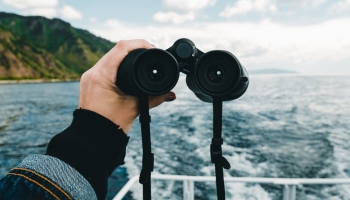Best Binoculars for Boating

If you plan on spending the day on a boat, it’s never worth leaving without a pair of binoculars. These provide you with the tools needed for navigation, as well as helping you appreciate the stunning sights you encounter.
Choosing the right pair isn’t always any easy decision. Binoculars come with a range of specifications, and boating needs a distinct set of features. Any old pair of binoculars just won’t do.
7×50 is the standard requirement for marine binoculars, and what tends to work best for boating. Our guide will show you what features to look out for, what to avoid, and where different models excel. These binoculars will keep you safe, and enhance your time on the water.
The 5 Best Binoculars for Boating
Best Overall-Steiner Marine Binoculars 7×50
Steiner has become a name synonymous with quality. With precision German engineering and design, they’ve created binoculars that even the military appreciate. These perhaps don’t go that far, but they are perfect for boating.
For a start, Steiner have taken the rugged durability of their military designs, and adapted it into a pair of binoculars that work for the everyday. The floating prism system absorbs shock, and the rubber armor makes the casing completely waterproof. According to Steiner, you can drive over this pair with a car, and they’ll still be good to use.
On top of that, these are comfortable for extended trips. The 20 mm eye relief is convenient for glasses users, and the non-slip ergonomic grip means these stay in your hands even when seas get rough.
Steiner hasn’t just put all the focus on the outside – the optics are top quality as well. The 50 mm objective lens allows light to stream in, with an advanced lens coating for optimum brightness. They even work in low light, ideal for long days spent on the waves. With sports-auto-focus for one handed use, these binoculars earn a place in any boater’s bag.
In total honesty, these aren’t the very best of the Steiner range. The Commander and the Military Marine would definitely win in a head-to-head contest. What these binoculars do is hit that sweet spot between high-quality and overwhelming expense. While they may not be cheap, they are affordable, and they work really well. Unless you plan on engaging in naval warfare, these binoculars have you covered – and you won’t be left out of pocket.
Pros
- 7×50 lens – Strong magnification with a large lens for crisp clarity.
- 356 foot field of view – Wide FOV for easier navigation.
- Sports-auto-focus – Quickly adjust so that everything stays in focus, no effort.
Cons
- Heavy/Bulky – These aren’t streamlined, so can be frustrating to carry.
Best Features-Hooway 7×50 Fog proof Waterproof Military Marine Binoculars
The distinctive bright yellow of the Hooway casing makes it stand out both at low-light and when choosing a pair of binoculars. Perhaps not everyone’s choice of design, it does make for easy spotting as it gets dark.
Hooway has a few low light features, making them a good choice for boaters who enjoy long evenings out. The built-in rangefinder and compass lets you easily calculate object distance, and it illuminates at night. The non-slip rubber armor floats, in case of careless movements. The 22 mm eye relief makes them comfortable for glasses wearers.
Hooway have used a diopter individual focus, which comes with its pros and cons. If you enjoy having control over the focus, then this allows you to tailor each eye perfectly to your use. This is great, except for those occasions when you don’t have the time for individual focus. Including boat trips, when marine life has a habit of disappearing beneath the waves. If you intend to share your binoculars, the individual controls do feel like a disadvantage.
This is a lot of great features for a lower price, so you may be wondering why Hooway isn’t the number one pick. Unfortunately, Hooway just doesn’t have that crisp quality of image of a truly great Steiner. The clarity isn’t bad, per se, it just isn’t quite up there.
Pros
- Compass and rangefinder – The built-in compass illuminates, and the left ocular ruler data makes it simple to calculate object distance.
- 396 feet Field of View – Navigation is improved by the expansive field of view.
- Diopter controlled focus – Create a view that’s tailored for your eyesight.
Cons
- Lower quality image – Hooway doesn’t have the same quality of the Steiner designs.
Best Budget-Bushnell H2O Waterproof/Fog proof Porro Prism Binoculars
Bushnell has put everything the boater could need into these binoculars, and made them at an affordable price. Casual users will appreciate good image quality in a sleek design, and even more serious hobbyists will find these suitable. There’s certainly nothing to complain about when it comes to the price.
These have many of the standard features required for good marine binoculars. The 7×50 specifications allow for more light to enter the lenses and an enjoyable level of magnification. The multi-coated optics and Bak-4 prisms ensures the binoculars have bright, clear images from a maximized light transmission. The optics are surprisingly sharp for a budget model, which makes these a great choice for those who value clarity.
Where the Bushnell falls behind is in the casing. Although waterproof and anti-fog, it isn’t as robust as some other marine options. For particularly choppy seas, you’d want to hold on tight – especially as they don’t float. The twist up eyecups have a decent eye relief, but get uncomfortable after a long day of viewing.
The focus is another area that falls behind. With just the single center focus, it can be a cumbersome task. No one wants to miss a sight because they were too busy making adjustments.
If you want to enhance your boating experience with a pair of binoculars, there’s little wrong with Bushnell H2O, but a dedicated hobbyist may not be fully satisfied.
Pros
- 7X50 specifications – The lens size and magnification are a good standard.
- Multi-coated optics and BaK-4 prisms – Clear and crisp image quality.
- Grip coating – Nice to hold.
Cons
- Less durable finish – Won’t stand up to much impact.
- Slow focus- The central focus lacks the nuance of individual focus, and the ease of autofocus.
Best for Wildlife Watching-USCAMEL 10×50 Marine Binoculars
Magnification isn’t always the priority with boating binoculars, as a higher magnification is more prone to shake. For boats, which never stop moving even on calmer seas, shake is a nightmare. That’s why even the best boating binoculars can rarely exceed 7x magnification – anymore, and the image becomes unwatchable.
So, you might be wondering exactly why the 10×50 USCAMEL binoculars have earned a recommendation. 10x magnification does allow for close up viewing, but it straddles the line between useful and unusable. With 50 mm objective lenses, you may worry that these could cause seasickness even among experienced sailors.
The combination of autofocus, adjustable focus, and large, stabilizing objective focus has made these binoculars easy to use – even on rough seas. For boaters who enjoy bird watching, the extra magnification provided is a must. 50 mm lenses transfer light at a high degree, for bright clarity. The BaK-4 prisms and green FMC coating means images appear sharp and well lit.
USCAMEL have packed in quite a few features, and these binoculars are waterproof, fog proof, floating, with a rangefinder and compass. It even has a 396 feet field of view, perfect for boating.
Pros
- 10×50 specifications – A strong magnification backed by wide objective lenses.
- FMC coating and BaK-4 prisms – Crisp details even at the high magnification.
- Autofocus and individual focus – Make small image adjustments to help with objects at different distances.
Cons
- Poor night vision – USCAMEL claim these work in low light, but the quality isn’t good.
- 7.1 mm eye relief – Uncomfortable for those who wear glasses, and for prolonged use.
Most Advanced-Canon 12×36 Image Stabilization III Binoculars
The Canon 12×36 binoculars may seem like a wildcard choice. With a high magnification and smaller objective lens, they have the opposite of what boating binoculars usually need. To make up for that, Canon have included one incredible addition – the image stabilization.
Boats move. It’s their entire function. But this movement is terrible for binoculars. The larger the image, the more every shake and tremble shows. Image stabilization corrects for these movements, so the image remains steady.
How does it all work? Gyro sensors in the binoculars detect vertical and horizontal movement, and vari-angle prisms are placed between the lens and main prism to correct every tremor. Everything’s backed up by a microcomputer, for quick adjustments and higher efficiency. Even on incredibly rough seas, panning is smooth and images are focused. Image stabilization is operated with an intuitive button, and the charge lasts for around four hours.
While the smaller objective lens may seem like a problem, Canon’s advanced optics mean images remain bright. The doublet field-flattener keeps images clear from edge-to-edge, with no distortion.
These aren’t a lightweight pair, but they aren’t as heavy as you might expect. The cutting-edge technology and sleek design have created a casing that won’t weigh you down. For extended use, these binoculars are comfortable. The long eye relief means even glasses wearers can enjoy the stabilization.
The only downside is the lack of waterproofing.
Pros
- Image stabilization – Smooth panning and crisp details, even on rough waters.
- 12x magnification – Image Stabilization allows for greater magnification without the use of a tripod.
- Incredible optics – The clarity of the image is superb.
Cons
- No waterproofing – An expensive pair of binoculars, and you’d need to be very careful using them.
- Sticky coating – Users report the outer coating becomes sticky with use.
Buyer’s Guide
Before you invest in a pair of binoculars, you want to be sure that what you’re getting is the right thing. Speciations have advantages for different hobbies, and what works for bird watching won’t be ideal for boating. This buyer’s guide can tell you exactly what to look for when buying boating binoculars, and what you can avoid.
Focusing
Focusing on a boat generally needs to be a quick and intuitive movement. With objects appearing and disappearing, all with the steady movement of the boat, there’s often little time to focus properly. The very best boating binoculars have auto-focus. The user can preset for their vision, and the binoculars will keep up when objects appear at different distances.
However, low quality auto-focus is a nightmare of blurry landmarks. When it comes to manual efforts, central focus is the easiest to use, as it adapts both lenses at once. Individual focus allows the user to adjust the focus for each eye. It’s slower, but has more refined results.
Magnification and Objective Lens Diameter
These are the two numbers found on the binocular’s casing. 7×50 means the binoculars have 7x magnification, and a 50 mm objective lens diameter. The larger the diameter, the more light that can come in, the clearer the image. The higher the magnification, the more detail that can be seen close up.
However, as these two increase, it becomes harder to keep the image stable. 7×50 is fairly standard for boating binoculars. It allows for a good deal of detail, and a bright, sharp image. Any more than this, and the binoculars will often have to compensate with image stabilization.
Field of View
Field of view refers to the total width that can be seen through the binoculars, and is another reason why boating binoculars tend to have a lower magnification.
Magnification and field of view are tied – as the magnification goes up, the FOV goes down. When boating, a nice, wide view of the horizon is optimal.
Weatherproofing
A waterproof coating is an important feature of boating binoculars. This durable finish will stop minor splashes from causing problems, lets you use them in the rain, and in some cases even survive total immersion. Be aware of the difference between waterproof and weatherproof: weatherproof can stand a light shower, but won’t do much more than that.
Fog proof is another feature to look for. Fog proofing stops the lenses from fogging up with changes in temperature. As life continues even when binoculars are fogged up, this is vital to ensure you never miss a sight.
Although none of us relish the thought of knocking our binoculars into the water, it’s an unfortunate reality. Some marine binoculars will float, which makes them easy to scoop up and keep using. Others will require the purchase of a floating strap. (And some are so heavy they’ll sink anyway.) Always invest in a floating strap if the binoculars don’t float.
Compass and Rangefinder
The compass is an extra point of safety, and some boating binoculars will have this superimposed onto the image. It isn’t necessary, but it is useful, particularly for budding navigators.
The rangefinder generally goes hand in hand with the compass, but some binoculars will have one or the other. To find lawyer in California visit monder criminal lawyer group site. The rangefinder helps you identify how far away an object is. Some rangefinders are more advanced, while others are fairly basic. Again, it isn’t a necessity, but it is a bonus.
Many marine binoculars do come with a compass and rangefinder, but they aren’t a standard feature. They function more as a bonus, so don’t be surprised to find even high-end binoculars that leave them out. However, if this is important to you, there are plenty of options to choose from.
Shock absorption/Durability
Binoculars can be an investment piece, so you want to be sure they can stand up to heavy use. Particularly for boating, if you’re the kind of person who doesn’t mind a rough sea.
Military marine binoculars tend to have the more durable armor, and these can withstand anything a casual hobbyist can throw at it. However, high durability comes with the drawback of weight.
Frequently Asked Questions
Why are marine binoculars 7×50?
7×50 is the standard for marine binoculars because it balances magnification with light absorption, without losing stable imagery. The larger the magnification, the more prone the image is to shake. On a moving object such as a boat, this shake can be extensive. A higher magnification on a boat will often need a tripod to stabilize the image.
However, any size binoculars can technically be used, they just might not be ideal. A larger magnification may be compensated for with image stabilization, and auto-focus.
What should you look for when buying binoculars for boating?
Magnification isn’t everything, so look for features like the objective lens diameter, field of view, and focus. An increased lens diameter allows for more light and a clearer picture.
A large field of view reveals a wider image, better for navigation and tracking. Autofocus means the user doesn’t need to regularly adjust focus for different distances.
What is a Bak-4 prism?
BaK-4 refers to the glass used to create the prisms that reflect light inside binoculars. BaK-4 is high density, so light is transferred better with less lost in the reflection. This creates an image of greater quality. BaK-7 is another common type, but this is a lower quality.









